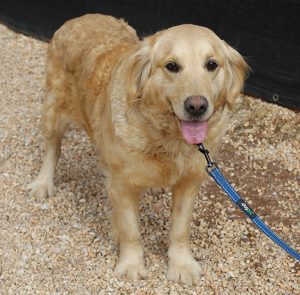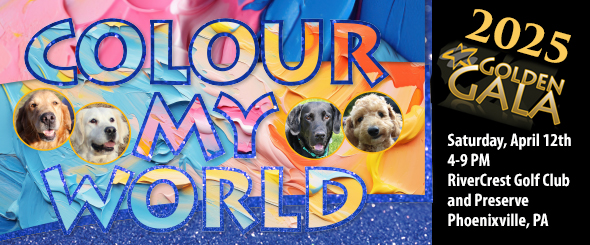
These commercial breeders have no interest in making sure the puppies are healthy, well-balanced representatives of the breed and no concern for the physical or emotional health of the parents. They view dogs as crop animals, not as family pets, and typically house them in squalid, appalling conditions. When the parent dogs are no longer useful for breeding, they are either “disposed of” or, if they are lucky, surrendered to a rescue organization like DVGRR. Here, we help prepare and transition Golden Retriever puppy mill survivors for life in an adoptive home.
Many of our prospective adopters tell us they had no idea what a puppy mill dog would really be like until they met one in person. Until you’ve seen the sad ravages of what their former life has done to these dogs, it’s hard to fully understand the extent of their needs. To help determine if adopting a puppy mill breeder dog may be right for you, we’ve prepared this list of commonly asked questions about the experience. We are also happy to talk with you in more depth or answer additional questions at any time.
Opening your heart and home to a breeder dog may seem daunting at first, but if you are up for the challenge and understand your dog’s needs, the experience can absolutely be one of the most rewarding ones of your life. You will truly be creating a “new beginning” for a dog whose life so far has seen little joy or happiness.
HOW DO PUPPY MILL BREEDER DOGS DIFFER FROM OTHER DOGS?
The first thing to understand about puppy mill survivors is that they have lived very different lives compared to most other dogs. They have been kept either in small cages isolated from people and other animals or housed with multiple dogs in cramped areas, forced to stand or lie in their own filth. They have been poorly socialized, meaning that that they have had little to no human contact and have not been exposed to everyday sights and sounds. Any contact they have had with humans is likely to have been negative, so they do not trust humans or know how to form a healthy relationship with them. Some have been handled cruelly or had other traumatic experiences. Amazingly, even with this type of background, puppy mill dogs can and will recover, once rescued and rehabilitated. Their resilience can be awe-inspiring.
HOW LONG DOES IT TAKE FOR A PUPPY MILL BREEDER DOG TO BECOME “NORMAL”?
Understandably, you may well ask if some dogs are too fearful or traumatized to ever lead normal lives. In our experience, the time frame and progression of improvement does vary greatly, depending on the dog’s background. Those that have been most severely neglected or have suffered traumatic experiences may certainly take longer to rehabilitate. Nonetheless, ALL puppy mill dogs have the potential to lead well-lived lives, lives that are a far cry from the dogs’ original existence. That said, living with a puppy mill breeder dog is a life-long commitment and adopters should expect to encounter different challenges along the way.
WHAT ARE SOME OF THESE TYPICAL CHALLENGES?
While each dog is of course unique, there are some characteristics that many have in common. Most puppy mill dogs will exhibit some level of the following, at least in the beginning:
- very timid around people — will not easily come close to people, may show discomfort with touching/petting, may “shut down” or hide when people approach
- may spend much of their day in a “safe spot,” such as behind a piece of furniture or in a corner
- fearful of sudden movements such as a person reaching out to them
- fearful of going through doorways
- fearful of new or unfamiliar objects in their environment
- may only eat when no one is around
- may not take treats from owner’s hand
- easily startled or frightened by loud or unknown noises that people or other dogs take for granted
- may be more afraid of men, especially those wearing hats
WHAT TRAITS IN AN ADOPTIVE HOME ARE BEST SUITED FOR A PUPPY MILL BREEDER DOG?
Here are some of the key factors an adoptive home should have in order to help a puppy mill dog succeed:
- a calm, quiet environment with minimal noise and commotion
- a secure fenced yard with a physical (i.e., not electronic) fence
- at least one other dog in the home to serve as a “mentor” to the breeder dog. If your existing dog is confident, active, and affectionate with your family, it will help teach your puppy mill dog to act this way as well
- patience and understanding — not expecting more than the dog can handle or getting overly frustrated
- an openness to set-backs and an ability to use creative techniques to move forward
- a sense of humor also helps tremendously!
WHY IS A PHYSICAL FENCE REQUIRED IN ORDER TO ADOPT A PUPPY MILL BREEDER DOG?
For the dog’s safety, we do require a physical fence and we do not make exceptions to this rule. Because these dogs are often very fearful, not only of people and their actions but also of startling noises, they have a high tendency to bolt. Should a puppy mill dog escape from your yard or other area, getting them to come back is extraordinarily difficult. They will not come willingly to a person, even if coaxed with food or other items that would tempt a normal dog. A fence also helps puppy mill dogs to feel secure and safe in their surroundings. Since these dogs are typically submissive in nature to humans, they are more sensitive to pain and do not recover quickly from experiences a confident dog could handle. This is why an invisible or electronic fence is not a viable option for a fearful dog.
HOW DO PUPPY MILL BREEDER DOGS REACT TO CHILDREN?
Children should, of course, always be supervised around any dog, but especially around a fearful dog. The activity level and boisterousness of young children may be overwhelming for such a dog, leading to an increase in the dog’s stress or anxiety level. It’s essential for adopters of puppy mill breeder dogs to learn how to identify signs of stress in a dog. Lowering of the head, a sideways glance, closed mouth – these are all signs your dog may be uncomfortable. To help minimize stress, a child should allow the dog to approach him, rather than the other way around. When the dog approaches, the child should be quiet, gentle, and calm, and should not lean over the dog. An adult should always be present to protect the dog from becoming overwhelmed. In general, adoptive homes made up of adults or older children are the best scenario for a breeder dog.
HOW WILL A PUPPY MILL BREEDER DOG REACT TO FRIENDS AND FAMILY WHEN THEY COME TO VISIT?
Friends and family members should take the same approach as children to your fearful dog. The adopter should be present so the dog has someone she knows and is comfortable with around her. Have your friends and family members sit with tasty treats and allow your dog to approach them. Let the dog sniff the newcomers and have them hand the dog a treat before attempting to pet. All visitors should act calm and gentle and not make any sudden or startling movements that may frighten the dog. Should you adopt a puppy mill breeder dog, it will be important that you are able to manage the environment so that visitors and new experiences are kept to a minimum, at least until your dog has progressed to a higher comfort level.
ARE PUPPY MILL BREEDER DOGS HOUSEBROKEN?
This is a question we are asked often, and is certainly an important one for potential adopters to take into consideration. Each dog is different, of course, and while the percentage of puppy mill dogs with housebreaking issues is certainly higher than that of the general dog population, most acclimate very well in this regard after adoption. Some do need a longer time to understand appropriate potty routines due to their background. Remember that most puppy mill breeder dogs have lived in cages or outside pens their entire lives and have had to use their personal area as a bathroom without anyone to clean up after them. Now they must adapt to a new routine, and this can take time and patience.
Another dog in the house will certainly help teach the puppy mill dog that going outside is where we potty. It’s also important to take the dogs out often and give lots of praise when the dog eliminates outside. Using baby gates while you are not home is a good way to keep the dog out of a carpeted area, while still allowing space to move around. Most dogs, when these techniques are implemented, become housetrained in about a month, according to our adopters.
CAN I TAKE MY PUPPY MILL BREEDER DOG FOR WALKS?
Yes, you can and you should! However, walking on leash can be challenging for many fearful dogs. Walking jointly with a confident dog is a great help, as it gives the puppy mill dog a friend to stick with and follow. Take treats on your walk to reward your dog when she performs well. We highly recommend the use of a front-attaching harness to keep the dog secure. We also recommend a martingale collar to prevent the dog from slipping the collar and getting loose should they “shut down” (become nervous and refuse to move) or pull back on the leash.
HOW ABOUT GROOMING? WILL THIS BE DIFFERENT THAN WITH OTHER DOGS?
Any new experience can be stressful for a fearful dog so you will need to discuss the puppy mill breeder dog’s special needs with your groomer before making an appointment. We suggest a patient groomer who has knowledge of fearful dogs and will use slow, gentle techniques – any rough handling will create a negative experience for your dog. It’s important to keep the grooming area as free of commotion and excess noise as much as possible. The ideal situation would be a mobile groomer or one that will allow you to stay during the appointment to serve as a secure presence for your dog.
HOW DOES DVGRR PREPARE PUPPY MILL BREEDER DOGS FOR LIFE IN A HOME?
We have been working extensively with puppy mill breeder dogs for over five years and our staff has developed strong skills in knowing how to start slowly with these dogs, gradually building more confidence and a higher comfort level with people. In 2009, we went a step further and created an innovative program called Project Home Life, which is specifically designed to rehabilitate puppy mill breeder dogs and help them transition from life in a cage to life in a home. Volunteers work with the dogs on various activities according to their individual progress level to help build confidence. The dogs learn to approach people for treats and pets, plus how to respond to different sights and sounds around the house including TVs, doorbells, and furniture. Dogs also learn how to play with interactive dog toys. As a dog progresses, we work on obedience skills, walking on leash, and overcoming obstacles.
WHAT SUPPORT IS PROVIDED TO ADOPTERS OF PUPPY MILL BREEDER DOGS?
We have developed a booklet called “Continuing the Journey” that is sent home with all dogs who have participated in Project Home Life. This booklet helps our adopters continue working on some of the same activities their dog learned in Project Home Life so they can maintain continuity. An online support group is available where you can seek input and suggestions from other DVGRR adopters who have already brought a breeder dog home. We can provide information on finding reputable trainers and our staff is always available via phone or email for information, guidance, and support of any kind.
SO WHY SHOULD I CONSIDER ADOPTING A PUPPY MILL BREEDER DOG?
After hearing about the unique challenges and issues involved with puppy mill breeder dogs, you may well be asking yourself if this is a journey you want to take. It is certainly not for everyone and if a fearful dog is not right for you, there are many other dogs that need wonderful homes. However, if you are drawn to the plight of the puppy mill breeder dogs and can respond to the challenges that may arise with adoption, please know that you will be providing a true second chance for a rescued dog. There is great reward and joy in watching a fearful dog wag her tail, bark for the first time, or learn to play with a toy. Yes, the progress takes place in baby steps, but if you have the patience, a positive attitude, and lots of love to share, you may just be what one of these special dogs needs.
ADDITIONAL RESOURCES
Because such a large number of rescued dogs arrive at our Golden Gateway campus from puppy mills, we have extensive experience in their rehabilitation. However, we also know that the training and conditioning we begin in the PHL program must continue after the dog is adopted. The dog’s journey continues, so we’ve created “Continuing the Journey” to help adopters continue to help their dogs!
We recommend the books Puppy Mill Dogs SPEAK!: Happy Stories and Helpful Advice, by Chris Shaughness with Chris Slawecki (both volunteers and adopters from DVGRR) and A Guide to Living With & Training a Fearful Dog by Debbie Jacobs. Both books provide a detailed look at living with and rehabilitating puppy mill dogs and other shy or fearful dogs and contain invaluable information and advice. We also recommend Rescue Your Dog From Fear by Peggy O. Swager. This book features tried-and-true techniques to help your dog feel secure.






